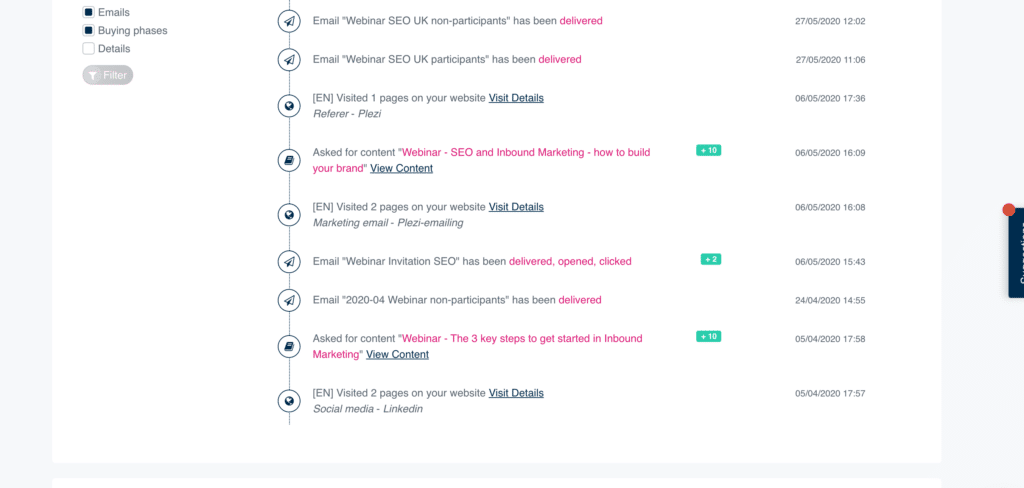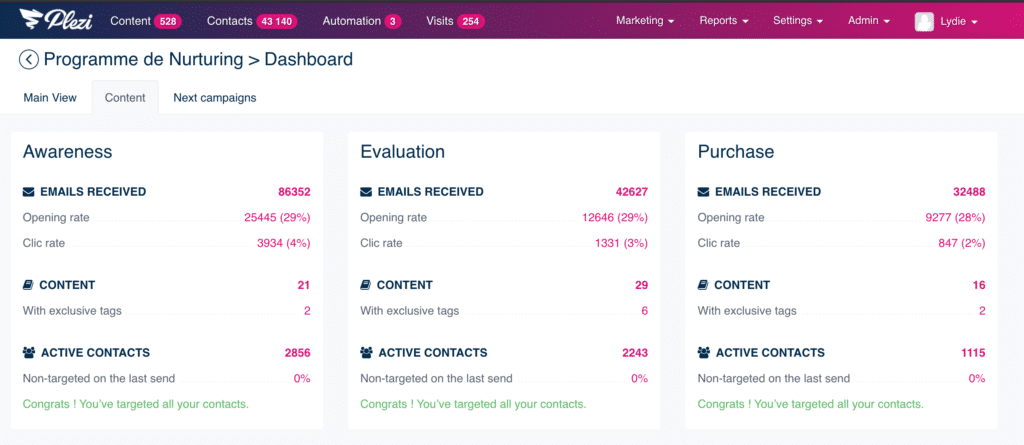A lot of marketers have come across the idea of lead scoring, without getting a full sense of what it entails. It is something that goes hand in hand with inbound marketing and a lead nurturing strategy. As you approach lead scoring, you will see that it is not complicated or too time-consuming to put in place, but it does involve understanding your business model, your target audience and buyer persona. It is essential for being able to identify quality leads to give to your sales team. But what does it involve exactly? What should be scored and how? Want to dig deeper?
01. Okay, we’ll bite. What’s lead scoring?
Lead scoring is a prospect-rating technique used to detect those leads that are further on in the buying cycle. What we would call ready-to buy – or an MQL. This allows sales reps to only process “hot leads” sent by marketing and not lose time and energy on an audience that is not ready to commit just yet.
Historically, salespeople used an “A, B, C” scale to rate leads they needed to focus on. This was a qualitative, not quantitative, rating. As long as they were not that many leads to process, it wasn’t too time-consuming. However, with the implementation of digital marketing and inbound marketing strategies, figures went up really fast. How could salespeople keep up?
This is where lead scoring comes into play: it aims to sort and identify from this vast audience which leads should be dealt with by the sales team as quickly as possible. In short, lead scoring is the ability to assess the maturity of a prospect and the suitability of our product or software for our target audience.
Although there are several levels in terms of lead scoring rules that can be put in place, it is important to know that most of the time, companies do not generate more than a hundred leads per month, so there is no need to put in place very sophisticated rules to identify which are the hottest prospects. In fact, the more complicated you make it, the less smoothly it works most of the time. Let’s see how you can work out which rules should apply to your strategy.
-
Distinguishing behavioural scoring from demographic scoring
Some leads are better than others. Depending on your activity, some leads will automatically be off-target. Some are very common: students, competitors, people who aren’t decision-makers, curious folk… Demographic scoring helps to gather intel on every person leaving their information on your website so that sales only contact people with commercial potential. For example, if you are a B2B solution and the contact is BtoC, they will not be in your target group.
This translates into the collection of information throughout the whole conversion process: intelligent forms (or progressive profiling) will ask prospects for more and more information each time they return to the site and make sure they qualify for your target.
Behavioural scoring, on the other hand, consists of identifying what a prospect does on the website, not who they are. It’s their actions that determine whether they should be transferred to sales. This made possible with tracking scripts. Each prospect who has already filled in a form on your website will then be recognised and all their interactions with your content will be monitored.
Behavioural scoring will allow the salespeople not to waste time calling people who have no potential and only skim your contents, or, on the other hand, adapt their sales pitch based on displayed interests.
An image from Plezi’s contact of viewed pages and scoring
-
Lead scoring as a bridge between marketing and sales teams
Lead scoring will allow your marketing team to identify what is called an MQL, or Marketing Qualified Lead. This lead has been qualified by the marketing teams and will be passed on to the sales force for appropriate and timely processing.
Defining rules with sales and agreeing with them on what you will consider to be a qualified lead for marketing with a Marketing / Commerce SLA (Service Level Agreement) is considered a best practice, and can really smooth out all your sales process.
The more precise this definition is, the more the sales and marketing teams are in agreement and the less you will hear remarks such as “Marketing is giving us bad leads” or “Sales people don’t process the leads we send them”.
Lead scoring is crucial for a startup and SMEs with no time to waste. No matter what the size of your marketing and sales teams, it will really save precious time.
02. How to set up your first lead scoring strategy
The first step is to make sure your content is evenly spread between all three stages of the buyer’s journey:
- Discovery
- Evaluation
- Purchase.
It’s trickier than it looks because your decision to whether hold onto a lead or pass it to the sales team will depend on the types of content this lead has consumed -and which stage within the buying cycle they are at. A prospect in the Discovery stage, even if really curious, might not be ready to buy yet.
For example, in our case: our target audience is learning about marketing automation. If a lead downloads our white paper called “What is marketing automation” (marked as a “Discovery” content), they don’t know what it is yet. It’s not the time to send it to the sales team because there are in a preliminary stage of reflection they need to go through.
On the other hand, if a lead downloads our white paper called “How to choose your marketing automation software” (an “Evaluation” content), we can say that they have chosen to equip themselves with a marketing automation software – or are in the process of thinking about doing so. . They need to be supported in their decision making, they most certainly have a project and might be ready to buy. Same thing if a lead asks for a quote on your website or requests a demo: they are probably in buying mode, already convinced about your product and trying to get more information to button everything up.
It is really important for the marketing manager to have the different stages of the buying cycle in mind and to be realistic about the expectations of prospects at these different stages. To do this, we have created a very simple method to map out your contents:
a. Setup of the lead scoring criteria
Once your content is sorted, it’s time to create a scale ranging from 0 to 50 to properly score them.
We usually go with this scale:
- All contents associated with the Discovery stage: 5 points.
- All contents associated with the Evaluation stage: 20 points.
- All content associated with the Purchase stage: 40 points.
Next, we consider that:
- A prospect in the Discovery stage will have a total between 0 and 20 points.
- A prospect in the Evaluation stage will have a total between 20 and 40 points.
- A prospect in the Purchase stage will have a total of 40 points or more.
Then, all you have to do send all contacts reaching the Purchase stage to the sales team. Ta-da!
You can, of course, be a bit more subtle: if a lead, for example, downloads 4 Discovery stage contents in a fairly short period of time, they will move on to the next stage: Evaluation, but you could also send it to the Sales team for a quick check-up, as they seem very interested. – to be qualified as an SQL.
By associating behaviour (consuming content) with a score, you can see clearly how and when a prospect forms an opinion on your topics and what you have to offer.
b. How to get the ball rolling in lead scoring
At first, don’t bother with trying to score everything. What matters the most is downloadable content: webinars, whitepapers… Scoring smaller actions like opening an email or reading an article can come later (or not come at all, if, in your context, it doesn’t provide more information). Little by little, you’ll be able to monitor your leads’ behaviour and set up scoring on actions from them that say a lot about what they think of you.
03. How to improve your lead scoring strategy
Set up the “Reality Check” rule. In other words, simply confront your initial hypotheses with reality. Does downloading this content specifically is really worth 30 points? Or, even better: what content all now-customers have read before buying from us, and should we up its score?
We usually monitor two pools of leads:
- the top ten content downloaders, to try to see what the sales team said about them. Did they become customers? What were their characteristics?
- the last ten clients signed that came from marketing, to see their score. What content did they read? Is their score high or low? What key action did they do?
Doing a Reality Check is essential in order to compare our lead scoring scale with the results and readjust the score if it does not correspond to reality.
04. Use Smart Campaigns to take prospects through the funnel
Once you have become certain of your content and feel confident that you have relevant pieces for each stage of the buying cycle we went through before (awareness, evaluation and purchase), you can actually automate your campaign by using Plezi’s Smart Campaigns. It means that our tool can understand who a customer is, where they are in the buying cycle and what they are interested in. It will send messages to those leads and you be able to identify quickly those that are interested in your content as they come through the funnel and you are automatically alerted. What’s more, the Smart Campaign itself will tell you all about what content is being consumed the most, what is working, what is not and what content you could be missing:
Whatever your lead scoring strategy or favourite tool, your main goal should be to keep it simple. In the end, what matters is to generate qualified leads and turn them into loyal customers. The only real trick is to think carefully about relevant content for your target audience -and only your audience. Having trouble with the first mapping step for your content? Great news: we have a free kit to help you tackle this crucial step.








